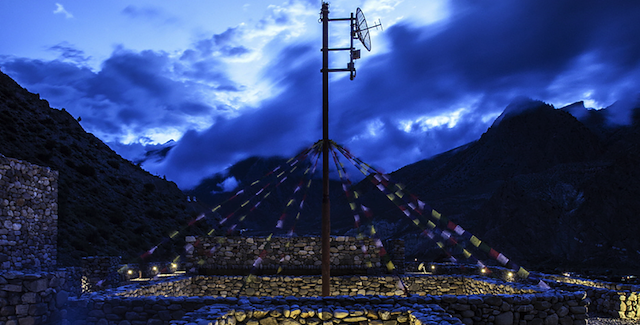Mustang is one of the most remote parts of Nepal: Nestled on the border of Tibet, it was one of the last parts of the country to encounter Westerners. It’s been described as a “hidden kingdom” that’s been “virtually unchanged since the 15th century”, but modern technology — like radio — is coming.
Radio is one of the most democratic technologies: It’s relatively cheap to produce and relatively cheap to access, with very few infrastructural investments necessary on the part of the producer. That’s what has made it so essential for everyone from explorers to political activists — and it still plays a crucial role for far-flung communities, like those in Mustang.
Though one Nepalese newspaper estimates that it usually only costs a few thousand dollars to build an upstart station, a Mustang town called Jomsom is now home to its first radio station, a $US930,000 building built by a South Korean communications giant.
Why is South Korea financing a radio station in rural Nepal? It turns out that the country offers a fair mount of aid in other forms: “We pushed for the project to build a broadcasting station as part of efforts to upgrade the cultural life of the donation beneficiary, a step forward from Korea’s traditional method of providing food, education and medical services in aid,” one official told the Yonhap News Agency.
Jomsom sits 8,400 feet about sea level — it’s hemmed in by the Himalayas, which have kept it closed off from the technological progress of communities further down the slopes. Its extreme altitude is part of the problem: According to Asia Radio Today, the village “could not be served easily by radio frequencies,” which left it cut off from news bulletins and the like. In a project funded by the Korea International Cooperation Agency, Korea’s second largest broadcasting company began a project to design and build a radio station that would connect Jomsom to the rest of the world.
To build this station — named Mustang Broadcasting Community — the company hired an architect named Kim In-cheurl, whose firm, Archium, was founded almost 30 years ago. The 8,000-square-foot station, which is perched on a windswept slope, was delayed over and over again due to the constant challenge of building in such a forbidding location, a rough terrain prone to extreme wind and temperature fluctuations.
Using gneiss stones sourced from around the site, local builders managed to construct a series of protective stone walls that shield the station’s inner rooms from the elements. Walking into the building, you must pass through a gneiss wall to descend into the sunken base, where the recording room and event space are.
A central courtyard anchors the technological crown of the building — the antenna — already strung with prayer flags. The South Korean coalition calls it “the most beautiful radio station in the world,” and it’s hard to argue with that summation.
Radio is the cheapest and most reliable way to bring information to isolated regions of Nepal and Tibet, which have struggled under not only environmental hardships but sociopolitical ones. Nepalese nonprofits like the Center For Rural Technology, which is helping operate the Mustang station, are trying to change that — and according to the Asia-Pacific Institute For Broadcasting Development, there are now 144 radio stations operating in rural Nepal.
Now that the building is open, what does it provide to the 2,000 or so people who tune in to its broadcasts? First and foremost, information: About safety, health, weather, news, or culture. There’s no word yet on whether we’ll be able to listen in online — and, after all, most of us won’t be able to understand its announcers — but it would still be cool to receive radio waves broadcast, at 8,000 feet above sea level, from one of the most isolated places on Earth.
Pictures: Jun Myung-jin/ArchDaily
